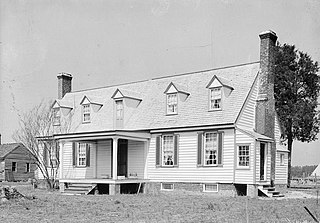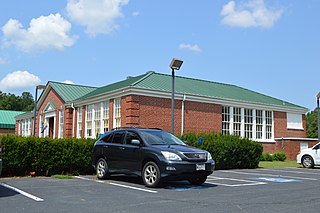Related Research Articles

Courtland is an incorporated town in Southampton County, Virginia, United States. It is the county seat of Southampton County.

Shirley Plantation is an estate on the north bank of the James River in Charles City County, Virginia. It is located on scenic byway State Route 5, between Richmond and Williamsburg. It is the oldest active plantation in Virginia and the oldest family-owned business in North America, dating back to 1614, with operations starting in 1648. It used about 70 to 90 slaves at a time for plowing the fields, cleaning, childcare, and cooking. It was added to the National Register in 1969 and declared a National Historic Landmark in 1970.

The Minor Basilica of Saint Mary of the Immaculate Conception is a Black Catholic parish in downtown Norfolk, Virginia. It is the oldest parish in the Diocese of Richmond and is known locally as "The Mother Church of Tidewater Virginia".

The Virginia Museum of Transportation (VMT) is a museum devoted to the topic of transportation located in Downtown Roanoke, Virginia, US.

Charles Morrison Robinson, most commonly known as Charles M. Robinson, was an American architect. He worked in Altoona and Pittsburgh, Pennsylvania from 1889 to 1906 and in Richmond, Virginia from 1906 until the time of his death in 1932. He is most remembered as a prolific designer of educational buildings in Virginia, including public schools in Richmond and throughout Virginia, and university buildings for James Madison University, College of William and Mary, Radford University, Virginia State University, University of Mary Washington, and the University of Richmond. He was also the public school architect of the Richmond Public Schools from 1910 to 1929. Many of his works have been listed on the National Register of Historic Places.

The Virginian Railway Passenger Station, also known as the Virginian Station is a former rail station listed on the National Register of Historic Places in the South Jefferson neighborhood of the independent city of Roanoke, Virginia, U.S.A. Located at the intersection of Jefferson Street SE and Williamson Road, the Virginian Station served as a passenger station for the Virginian Railway between 1910 and 1956. The station was the only station constructed with brick along the entire length of the Virginian's 608 miles (978 km) network. It was severely damaged by fire on January 29, 2001.

Sabine Hall is a historic house located near Warsaw in Richmond County, Virginia. Built about 1730 by noted planter, burgess and patriot Landon Carter (1710–1778), it is one of Virginia's finest Georgian brick manor houses. Numerous descendants served in the Virginia General Assembly. It was added to the National Register of Historic Places in 1969, and declared a National Historic Landmark in 1970. At the time of its National Register listing, it was still owned by Carter / Wellford descendants.

The Virginia Park Historic District is located on the north side of New Center, an area in Detroit, Michigan, along both sides of Virginia Park Street from Woodward Avenue to the John C. Lodge Freeway access road. The district was listed on the National Register of Historic Places in 1982.
This is a list of the National Register of Historic Places listings in Norfolk, Virginia.

Greenway Plantation is a wood-frame, 1+1⁄2-story plantation house in Charles City County, Virginia. Historic Route 5 and the Virginia Capital Trail bikeway, both of which connect Williamsburg and Richmond pass to slightly south of this private home. Located just west of the county seat Charles City Courthouse, Virginia, Greenway is one of Charles City's earliest and most distinctive Colonial plantations. It was added to the National Register of Historic Places in 1969. Other Virginia historic sites built in the same era and with similar names are considerably west: Greenway Court, Virginia, built in 1747 and mostly demolished in the 1830s, now in Clarke County, and Greenway a house built circa 1780 for Francis Madison, the brother of President James Madison.

Douglass High School was built in 1941 in what was then a rural area just outside Leesburg, Virginia as the first high school for African-American students in Loudoun County. The school was built on land purchased by the black community for $4,000 and conveyed to the county for $1. It was the only high school for African-American students until the end of segregation in Loudoun County in 1968.

Buena Vista Colored School is a historic school building for African American children located at Buena Vista, Virginia. It was built in 1914, and expanded in 1926. It is a one-story, brick structure with a hipped, sheet metal roof. Also on the property is a contributing brick outbuilding once used to store wood and coal. The building served as the only local school for African American children in grades 1–7 from 1914 to 1957. The Buena Vista Colored School Historical Society was organized in 2002 to restore the school as a museum and community center.

Armstead T. Johnson High School is a historic high school complex for African-American students located near Montross, Westmoreland County, Virginia. The main building was built in 1937, and is a one-story, "U"-shaped Colonial Revival style brick building. Contributing structures on the property include the one-story, frame Industrial Arts Building and the one-story, frame Home Economics Cottage. At a time when the state had a policy of legal racial segregation in public schools, this was among the first purpose-built high schools for African Americans on the Northern Neck of Virginia.

Armstrong Elementary School is a historic elementary school for African-American students located at Lynchburg, Virginia. It opened in 1954, and consists of five sections: the two-story, 12-bay long, brick veneer classroom block; the shorter, rectangular-shaped cafetorium on the northeast end of the classroom block with a smaller kitchen wing; a large rectangular gymnasium on the rear; and the adjacent small boiler room. It is in the Streamline Moderne style. The property includes the site of the original school that was demolished in 1959. It was built as an equalization school prior to the Brown v. Board of Education decision that struck down racial segregation in public schools.
Lafayette Grammar and High School, also known as Lafayette I.O.P. Center, is a historic school complex located at Norfolk, Virginia. The grammar school was built in 1905, and is a two-story brick building in the Colonial Revival style. It has a slate covered hipped roof and arched window openings. The high school was built in 1910, and is a two-story brick building connected to the grammar school. The school was abandoned in 1970.

First Calvary Baptist Church is a historic African-American Baptist church located in Norfolk, Virginia. It was built in 1915 and 1916 and is a four-story, 11 bay, brick church building in the Second Renaissance Revival style. The building features decorative terra cotta and a stained-glass dome. It has a two-tier, engaged entrance portico with fluted columns, Corinthian order capitals, and terra cotta entablatures. The building also has a three-stage bell tower.

St. John's AME Church is a historic congregation of the African Methodist Episcopal Church in Norfolk, Virginia, United States. Founded in 1840, it was the first African American Episcopal Church in Virginia. It moved to its present location on East Bute Street in what is now Downtown Norfolk in 1848.

Queen Street Baptist Church is a historic African-American Baptist church located at Norfolk, Virginia. It was built in 1910–1911, and is a rectangular one-story brick church in the Late Gothic Revival style. The façade and side elevations have Gothic pointed arch windows and the church is topped by a spire that rests atop the roof at the façade. An educational annex was built in 1952, and expanded in 1957. The Queen Street Baptist Church congregation dates to 1884.

American Cigar Company are two historic cigar factory buildings located at Norfolk, Virginia. The buildings were built about 1903 and consist of a stemmery and the boiler room. Albert F. Huntt is credited as the architect. The American Cigar Co. was created in 1901 as a subsidiary of the American Tobacco Company. It was listed on the National Register of Historic Places in 2009.

First Battalion Virginia Volunteers Armory, is a historic armory building located in Richmond, Virginia. It was built in 1895, and is a two-story. Late Victorian style brick structure. It also is known as the Leigh Street Armory, the Monroe School, and the Monroe Center.
References
- 1 2 "National Register Information System". National Register of Historic Places . National Park Service. July 9, 2010.
- ↑ "Virginia Landmarks Register". Virginia Department of Historic Resources. Retrieved March 19, 2013.
- ↑ Kimble A. David (August 1999). "National Register of Historic Places Inventory/Nomination: John T. West School" (PDF). Virginia Department of Historic Resources. and Accompanying photo
- ↑ "Former black school in Norfolk demolished". Daily Press (Virginia) . August 9, 2006. p. C4. Retrieved September 3, 2022– via Newspapers.com.

